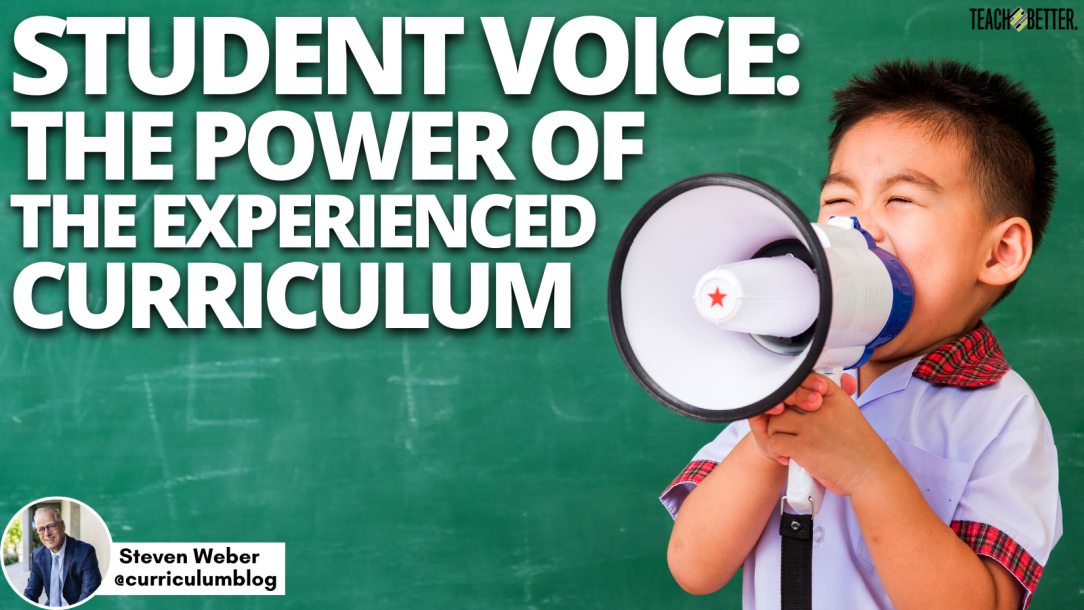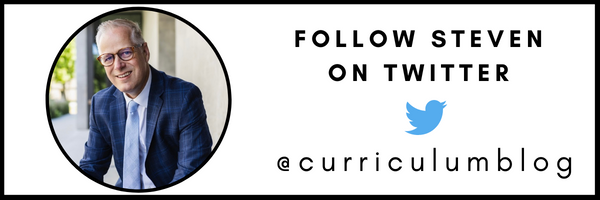TL;DR:
- The written curriculum and taught curriculum are different from the experienced curriculum.
- Teachers should find ways to obtain feedback from students on their experienced curriculum.
Hundreds of books and articles have been written addressing the curriculum in schools. Teachers and administrators have read books describing the written, taught, assessed, enriched, prioritized, or guaranteed curricula. In addition to these common topics, authors have described curriculum alignment, concept-based curriculum design, curriculum mapping, unpacking standards, rigorous curriculum design, balanced curriculum, backward design, culturally responsive curriculum, and basic principles of curriculum and instruction. However, rarely do authors explore the “experienced curriculum.”
Teachers may be able to develop a rigorous curriculum, but relevance may be more possible when we view the unit and lessons through the eyes of each learner. Click To TweetThe Experienced Curriculum
One key curriculum area that is often overlooked is the “experienced curriculum.” The written curriculum nonetheless does not have the same impact on each student in a classroom or across classrooms in the same school. Despite the best curriculum plan, there are several barriers (visible and invisible) students encounter including poverty, hunger, housing, mental health, teen parenting, substance abuse, time management, study skills, lack of confidence, employment after school hours, and anxiety. When we create a curriculum, there is no way educators can predict how the student will receive the curriculum.
Instructional Moves
Individual teachers provide pre-assessments, authentic assessments, and exit tickets in order to assess student understanding. Based on these different types of assessments, teachers make instructional moves to support the needs and readiness levels of each learner. Individual teachers understand the importance of assessment and providing feedback to each learner.
However, school and district-level teams frequently spend the majority of their time writing or revising the written curriculum, developing common formative assessments, or reflecting on instructional strategies. The written curriculum is focused on inputs, while the experienced curriculum is focused on the student experience. The purpose of this article is to encourage teacher teams to identify additional ways to include student voices in curriculum design.
Traditional Curriculum Design
Curriculum design and deliberation are equally important for school and district-level teams. Without curriculum design, it is challenging for each teacher to have a common curriculum across schools in a school district. Curriculum development is a thought-provoking process. It enables teachers to have professional conversations about the intended and taught curriculum.
In addition to horizontal alignment, curriculum design provides educators with the opportunity to discuss what is essential across grade levels and in other courses. In other words, traditional curriculum design is focused on what each student should know and be able to do.
The Ultimate Validation of a Curriculum
When teachers ask students to share their thoughts related to the written and taught curriculum, they may discover new approaches for supporting student understanding. “The ultimate validation of a curriculum lies in its results; that is, did it help students achieve the desired outcomes?” (Wiggins & McTighe, 2007, p. 159).
For example, fast food restaurants, businesses, concerts, and banks give feedback forms to customers on receipts, QR codes, text messages, and via email. Seeking feedback from the customer informs future customer experiences. Similarly, if we truly want to understand the impact of the curriculum, educators need to develop mechanisms for soliciting feedback from the students.
Lagging Data
Teachers and school districts can collect lagging data in the following ways:
- Offer a student survey at the end of each course.
- Survey students through focus groups at the end of their senior year.
- Purchase data from the National Student Clearinghouse.
- Send a survey to college freshmen regarding how well high school prepared them for college.
Collecting information only on lagging indicators is like “playing the game with the scoreboard off. When the buzzer sounds at the end of the game, you flip the scoreboard on and say, ‘Wait a minute. I thought we were ahead’” (Foley, Mishook, Thompson, Kubiak, Supovitz, & Rhude-Faust, 2008, p. 3).
Possibilities for the Experienced Curriculum
Teachers can analyze student grades and reflect on exemplary student work. In addition, they can discuss whether or not students appeared to be engaged throughout the unit. Each student brings their own lived experience(s) to each class. For instance, a student may be confident in 3rd-period Algebra I but may feel lost or lack confidence in 4th-period U.S. History.
Each student brings strengths to school. A strengths-based curriculum focuses on the feedback from students, rather than exclusively focusing on the scope and sequence outlined by a group of teachers. By having conversations with students about the curriculum and assignments, we may have a more well-rounded view of the student’s experience. While each student may have a different experience, we will develop a better understanding of our students. Teachers may be able to develop a rigorous curriculum, but relevance may be more possible when we view the unit and lessons through the eyes of each learner.
Can our school create a system for students to share about the experienced curriculum?
“Leading indicators enable education leaders, especially at the central office level in a school district, to make more strategic and less reactive decisions about services and supports to improve student learning” (Foley, Mishook, Thompson, Kubiak, Supovitz, & Rhude-Faust, 2008, p. 2).
Consider the following options for student voice:
- Students can self-assess in the middle of a project and can reflect on their final product
- Student Advisory
- A survey at the end of each unit
- Begin class once a week by asking 1-3 questions about the “student experience”
- Focus groups
- Use Post-it Notes and ask each student to provide one answer
- Ask students to share as they exit class (i.e., PE, Music, Library, etc.)
- Use technology such as Flip
- Embed a survey question as a Ticket-Out-The-Door
The Student Experience
Think about organizations or businesses that focus on creating the best possible customer experience (concerts, hotels, conferences, retail stores, or restaurants). The customer experience is their main focus because it is connected to profit. However, in the field of education, teachers and administrators do not have the same goal. Sheninger and Murray (2017) wrote, “There needs to be a Return on Instruction (ROI) that results in evidence of improved student learning outcomes.”
In addition to evidence in the form of grades and student projects, student voice can play a powerful role in assessing the enacted curriculum. “When students see how the power of their voices contributes to the class, the learning community becomes increasingly centered on student efficacy” (Plotinsky, 2022). We know when the curriculum is taught or when the unit assessment has been scored, but do we know how the students experienced the curriculum? What are the next steps for your team?
[scroll down to keep reading]12 Questions to Ask Students
Questions can be adapted based on the age of students.
- What was your favorite part of this unit?
- Do you feel empowered as a learner based on the assignments in this unit?
- Do you feel like the assignments in this unit are challenging?
- How could the assignments be more relevant to students your age?
- Are there opportunities for student choice and student voice throughout the school day? Which classes or assignments provided you with student choice and voice?
- What is your preferred learning style?
- Do you see yourself reflected in the curriculum and materials we use in class?
- What are the barriers that you face as a learner?
- How could technology be used or incorporated into assignments to make learning more fun and relevant?
- Are there times that you think technology or tech tools are overused in school?
- What has been your favorite assignment this school year? Please share the class and what made this your favorite assignment.
- What would you change about teaching and learning at your school?
Key Definitions
Written Curriculum
Outlines key skills, concepts, and student dispositions; provides teachers with a road map for determining instructional strategies, assignments, and academic support. The written curriculum may be designed by the school district, purchased, written by teacher teams, or created by individuals.
Taught Curriculum
The curriculum that is taught in classrooms. The taught curriculum may or may not reflect the written curriculum. There are days when the lesson goes in a different direction or when students play a more active role in co-creating what is taught.
The Experienced Curriculum
How did students experience the curriculum? Does our school have a system in place to analyze the impact of the written and taught curriculum on each learner? Student products highlight how students experienced the curriculum, but products do not tell the whole story. Student voice empowers the learner and teachers to make future decisions related to the student experience.
References
Foley, E., Mishook, J., Thompson, J., Kubiak, M., Supovitz, J., & Rhude-Faust, M. K. (2008). Beyond test scores: Leading indicators for education. Annenberg Institute for School Reform.
Plotinski, M. (2022). Creating a classroom that is student, not teacher, driven. Edutopia. Retrieved from https://www.edutopia.org/article/creating-classroom-student-not-teacher-driven
Sheninger, E., & Murray, T. (2017). Learning transformed: 8 Keys to designing tomorrow’s schools, today. ASCD.
Wiggins, G. & McTighe, J. (2007). Schooling by design. ASCD.
About Steven Weber
Dr. Steven Weber is a curriculum leader. He has served on multiple state and national boards. His areas of research include curriculum design, multiplying leaders, professional learning, and school leadership.




